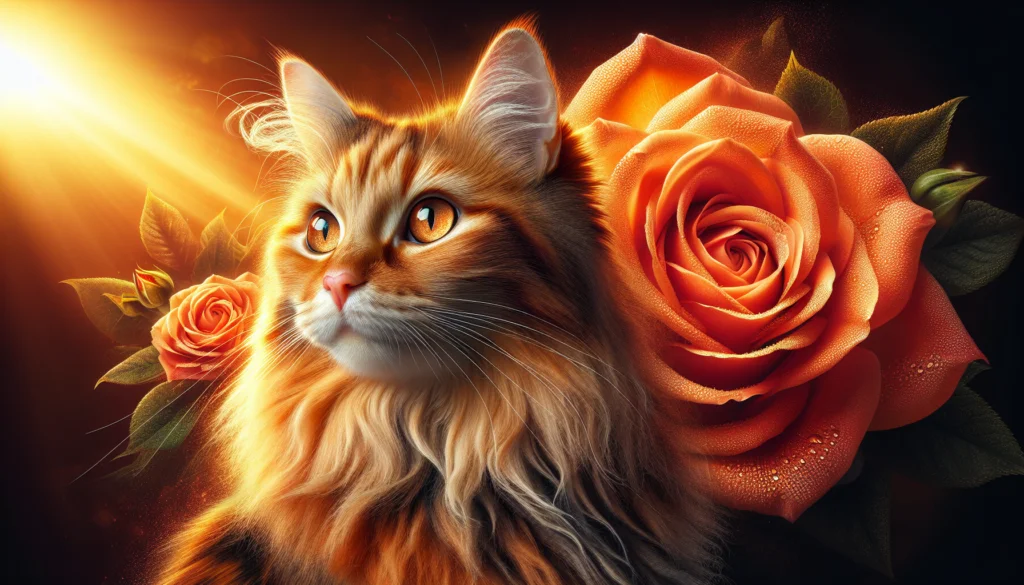Are you curious about the rarity of female orange tabby cats? Well, wonder no more! In this article, we will explore the fascinating world of feline genetics and shed some light on whether female orange tabby cats are indeed a less common sight. With their vibrant orange coats adorned with beautiful stripes, these felines have captured the hearts of cat lovers worldwide. So, let’s embark on this captivating journey and discover the truth behind the rarity of female orange tabby cats!

What is an Orange Tabby Cat?
Definition of an Orange Tabby Cat
An Orange Tabby cat is a specific coat color pattern found in domestic cats. These cats have a vibrant orange or reddish fur with distinctive dark stripes or spots on their body. The term “tabby” refers to the pattern of stripes or spots rather than a specific breed. Orange tabbies are known for their friendly and sociable nature, making them popular pets in many households.
Physical Characteristics of Orange Tabby Cats
Orange tabby cats typically have a medium to large-sized body with sturdy builds. They have round faces with expressive eyes that can range in color from green to amber. These cats have soft and dense fur, which is usually on the shorter side, making grooming relatively easy. Their coats may have variations in shade, from a pale orange to a deep burnt orange. The distinct tabby pattern can vary as well, with some cats having thick stripes while others may exhibit a marbled or blotched pattern.
Variations of Orange Tabby Cats
Orange tabby cats can display various coat patterns within the tabby category. The most common pattern is the classic or mackerel tabby. This pattern consists of thin, parallel stripes running vertically along the cat’s body, resembling the letter “M” on the forehead. Another variation is the spotted tabby pattern, where spots or rosettes replace the stripes. Additionally, some orange tabby cats may have a tabby pattern on a solid orange background. These variations make each orange tabby cat unique and visually appealing.
Gender Distribution in Tabby Cats
Male vs Female Orange Tabby Cats
In tabby cats, including orange tabbies, there is a notable difference in the gender distribution. Orange tabby cats are predominantly male. It is estimated that approximately 80% of all orange tabbies are male. This gender distribution discrepancy has intrigued many cat enthusiasts and researchers, leading to further exploration of its underlying causes.
Percentage of Female Orange Tabby Cats
While male orange tabby cats are the majority, the remaining 20% consists of female orange tabbies. This makes female orange tabbies relatively rare compared to their male counterparts. The smaller percentage of female orange tabbies adds to their uniqueness and allure for those seeking a special feline companion.
Reasons for Gender Distribution Differences
The reason behind the gender distribution disparity in orange tabbies lies in genetics. The orange fur color in cats is linked to the X chromosome. Female cats have two X chromosomes, while males have one X and one Y chromosome. The presence of two X chromosomes in females makes it less likely for the orange gene to be expressed in its dominant form, resulting in fewer female orange tabbies. However, exceptions to this genetic phenomenon are still observed, allowing for the existence of female orange tabbies, albeit in smaller numbers.
Genetics of Orange Tabby Cats
Understanding the Orange Coat Color
The orange coat color in tabby cats is a result of a gene called the “O gene.” This gene is responsible for the production of orange pigments, specifically the pigment called pheomelanin. When the O gene is present and dominant, it overrides other coat color genes, resulting in the distinct orange coloration seen in tabby cats.
The Role of the X Chromosome
The O gene is located on the X chromosome, which is present in both male and female cats. However, its expression is influenced by the number of X chromosomes a cat possesses. For a male cat, having only one X chromosome means that the O gene is either present or absent, leading to a higher likelihood of expressing the orange coat color. On the other hand, female cats have two X chromosomes, and the presence of two O genes can result in a dilution of the orange color, leading to variations such as tortoiseshell or calico patterns.
Inheritance Patterns of the Orange Gene
The O gene follows an inheritance pattern that conforms to Mendelian genetics. This means that the presence or absence of the O gene is determined by whether the cat inherits an “O” allele or a “non-O” allele from each parent. A cat with two “O” alleles will have an orange coat, while a cat with two “non-O” alleles will not exhibit the orange tabby pattern. In the case of female cats, having one “O” allele and one “non-O” allele can lead to the expression of the orange gene in a diluted or mottled form, resulting in tortoiseshell or calico patterns.
Common Coat Colors in Female Cats
Calico Cats
Calico cats are renowned for their uniquely beautiful coat patterns, which consist of three distinct colors – orange, black, and white. These cats exhibit patches or splotches of different colors, forming intricate patterns. The patches can be large or small and are usually distributed randomly across the cat’s body. Calico cats are almost exclusively female, as the calico coat color is linked to the presence of two X chromosomes.
Tortoiseshell Cats
Tortoiseshell cats, often called “torties,” have coat colors that resemble a blend of orange and black or brown patches. These patches create a mosaic-like pattern on the cat’s fur. Unlike calico cats, tortoiseshell cats can have varying amounts of white mixed into their coat. The presence of both orange and black or brown patches in the coat is due to the interaction of the orange gene and other coat color genes. Tortoiseshell cats can be either male or female, but the majority are female.
Tabby Cats and Coat Color
Tabby cats can display a variety of coat colors, including orange. The tabby pattern refers to the unique stripes or spots found on the fur, regardless of the actual color. While tabby cats can be orange, they can also be gray, brown, or even silver. The tabby pattern can occur with any coat color, making it a versatile and common pattern seen in cats of various hues.

Rareness of Female Orange Tabby Cats
Statistical Rarity
Female orange tabby cats are considered relatively rare within the feline population. The majority of orange tabbies are male, making up around 80% of the total orange tabby cat population. As a result, female orange tabbies comprise only a small percentage of the already limited number of orange tabby cats.
Factors Influencing Rarity
The rarity of female orange tabby cats can be attributed to both genetic and statistical factors. The genetic factor lies in the presence of two X chromosomes in female cats, making it less likely for the dominant orange gene to be expressed without any dilution or modification. Additionally, statistical factors play a role, as the overall number of orange tabby cats is already lower compared to other coat colors, intensifying the scarcity of female orange tabbies.
Case Studies of Female Orange Tabby Cats
While female orange tabby cats may be rare, numerous case studies and anecdotal evidence highlight their existence. These cases often pique interest and fascination among cat enthusiasts, creating a sense of curiosity regarding the genetic mechanisms that allow for the development of female orange tabby cats. Their rarity adds to the allure and desirability of these unique feline companions.
Adopting a Female Orange Tabby Cat
Finding a Female Orange Tabby Cat
Finding a female orange tabby cat may require some patience and effort, given their relative rarity. Local animal shelters, rescue organizations, and reputable breeders can be good places to start the search. Networking within the cat-loving community and online platforms dedicated to cat adoptions can also provide leads to potential female orange tabby cats in need of a loving home.
Considerations for Adoption
Before adopting a female orange tabby cat, it is essential to consider various factors. These include your living situation, available space, and compatibility with existing pets. Additionally, understanding the specific needs and temperamental traits commonly found in orange tabby cats can help ensure a harmonious and fulfilling companionship.
Tips for Caring for a Female Orange Tabby Cat
Once adopted, caring for a female orange tabby cat is similar to caring for any other feline companion. Regular veterinary check-ups, a balanced diet, proper grooming, and plenty of attention and love are essential. Orange tabbies, known for their sociable nature, thrive on human interaction and enjoy activities that stimulate their minds and bodies, such as interactive playtime and puzzle toys. Providing a safe and enriching environment will help ensure the well-being and happiness of your female orange tabby cat.
Famous Female Orange Tabby Cats
Celebrity Cats
Throughout history, there have been several famous female orange tabby cats that have captured the hearts of millions. These cats often gain celebrity status due to their unique appearances, memorable personalities, or their owners’ fame. Some notable celebrity cats include Morris, the finicky feline known for his role in advertising campaigns, and Garfield, the lovable lasagna-loving comic strip character.
Internet Sensations
In the age of the internet, many cats, including female orange tabbies, have risen to online fame. These feline internet sensations often gain popularity through viral videos and social media platforms. Their distinct orange coats and charming antics captivate audiences worldwide. Some examples of famous female orange tabbies include Nala Cat, Venus the Two-Faced Cat, and Pudge, all of whom have amassed large followings and continue to bring joy to their fans.
Notable Fictional Characters
Female orange tabby cats have also graced the pages of books, comics, and movies as beloved fictional characters. These characters often leave a lasting impression and become iconic in their own right. One such example is Crookshanks, Hermione Granger’s loyal and intelligent pet in J.K. Rowling’s Harry Potter series. Crookshanks’ distinctive orange tabby appearance and intuitive nature made him a memorable addition to the magical world of Hogwarts.
Orange Tabby Cat Myths and Superstitions
Beliefs and Folklore
Across different cultures and regions, beliefs and folklore surrounding orange tabby cats have emerged. In some cultures, orange tabby cats are believed to bring good luck and prosperity to their owners, while others consider them symbols of wealth and abundance. Folklore often portrays these cats as affectionate and intelligent companions with a special connection to the spiritual realm.
Misconceptions about Orange Cats
Despite their positive reputation, orange cats, including orange tabbies, have fallen victim to misconceptions and stereotypes. One prevalent misconception is that orange cats, specifically male orange cats, are more aggressive or prone to misbehavior. However, there is no scientific evidence to support this claim, and in reality, orange tabbies are known for their friendly and outgoing nature.
Superstitions Surrounding Orange Cats
Superstitions surrounding orange cats have also been prevalent throughout history. In some cultures, they are considered omens of good fortune and prosperity, while others associate them with bad luck or witchcraft. These superstitions vary widely, and it is important to remember that they are based on folklore rather than scientific fact. It is always best to judge each individual cat based on their unique personality and not rely on superstitions.
Other Rare Color Variations in Tabby Cats
Silver Tabby Cats
While orange tabby cats are known for their vibrant hues, silver tabby cats offer a strikingly different color variation. Silver tabby cats have a pale silver or gray coat with dark gray or black markings, creating an elegant and regal appearance. These cats are known for their distinctive silver-striped or marbled patterns, making them a visually stunning variation of the tabby coat.
Solid Colored Tabby Cats
Tabby cats are often associated with their distinctive patterns, but they can also come in solid colors. Solid colored tabby cats have coats without any visible stripes or spots, showcasing a uniform color throughout. Common solid colors include black, gray, brown, and even white. These cats display the tabby pattern genetically, but it is masked by a solid coat color, resulting in a unique combination of traits.
Blue Tabby Cats
Blue tabby cats, also known as gray tabbies, possess a blue-gray coat color with darker gray or black markings. The blue tabby coat is often seen in breeds such as the British Shorthair and the Chartreux. These cats have a calm and gentle demeanor, accentuated by their subtle yet captivating coat pattern.
Conclusion
Female orange tabby cats, although relatively rare, add a touch of uniqueness to the feline community. Their vibrant orange coats, coupled with their friendly and sociable personalities, make them cherished companions. Understanding the genetics behind the orange tabby coat color and the gender distribution differences helps illuminate the science behind their rarity. Whether seeking to adopt a female orange tabby cat or simply appreciating their beauty, these feline wonders continue to captivate the hearts of cat lovers around the world.

